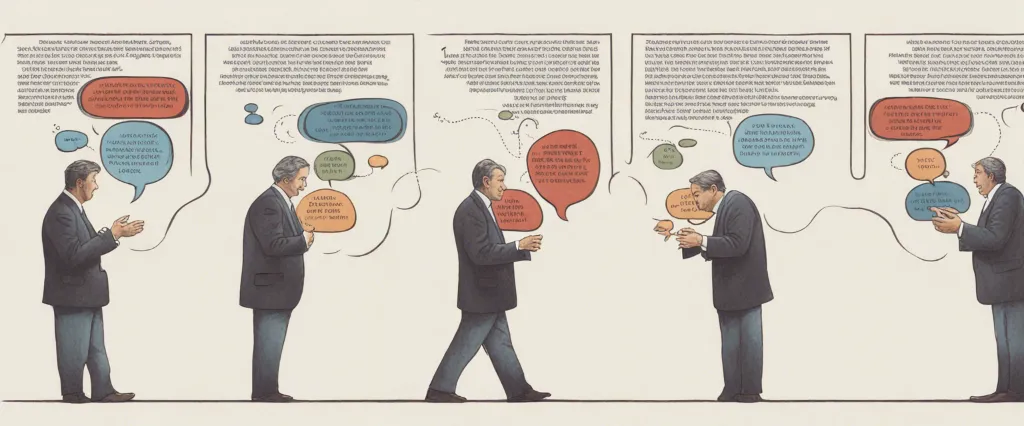In “How Successful People Think,” acclaimed author John C. Maxwell delves into the fascinating realm of the mindset that distinguishes high achievers from the average individual. Through his insightful analysis and practical guidance, Maxwell exposes the core principles and thought processes that enable success in every aspect of life. With a profound understanding of human psychology and extensive experience in leadership development, John C. Maxwell is recognized worldwide as an authority on personal growth and achievement. As a bestselling author, speaker, and coach, he has inspired countless individuals to transform their lives and realize their full potential.
Chapter 1: The Power of Thinking – Harnessing the Potential of Your Thoughts
In Chapter 1 of “How Successful People Think” by John C. Maxwell, titled “The Power of Thinking – Harnessing the Potential of Your Thoughts,” the author emphasizes the crucial role that thoughts play in shaping one’s life and success. Maxwell opens by highlighting the significance of thoughts, stating that they control emotions, actions, and ultimately, destiny.
He discusses the importance of developing a positive mindset and the impact it can have on achieving goals. Maxwell asserts that successful individuals possess the ability to think differently, allowing them to see opportunities that others may overlook. He emphasizes that thinking requires effort, discipline, and practice.
Maxwell introduces eleven types of thinking that successful people cultivate. These include big-picture thinking, focused thinking, creative thinking, realistic thinking, strategic thinking, possibility thinking, reflective thinking, informed thinking, questioning thinking, popular thinking, and unselfish thinking. He delves into the characteristics of each type and demonstrates how they contribute to success.
Furthermore, Maxwell emphasizes the importance of engaging in intentional thinking. He advises readers to set specific times and places aside for thinking, avoiding distractions and interruptions. He suggests adopting habits such as reading, journaling, and observing to fuel one’s thinking process.
In this chapter, Maxwell lays the foundation for the book, stressing that thinking is a game-changer in achieving success. By guiding readers through different types of thinking and providing practical strategies to develop a strong thinking habit, Maxwell encourages individuals to harness the power of their thoughts and unlock their potential for success.
Chapter 2: The Big-Picture Thinking – Developing a Strategic and Visionary Mindset
Chapter 2 of “How Successful People Think” by John C. Maxwell, titled “The Big-Picture Thinking – Developing a Strategic and Visionary Mindset,” focuses on the importance of strategic thinking and having a long-term vision for success. Maxwell starts the chapter by emphasizing the need to think beyond the present moment and have a broader perspective.
The author argues that successful people have a unique ability to think strategically and envision the future. They can see beyond immediate circumstances and consider the long-term implications of their actions. Maxwell suggests that this kind of thinking is crucial for making wise decisions and achieving extraordinary accomplishments.
To develop a strategic and visionary mindset, Maxwell recommends several key steps. Firstly, he encourages readers to break away from the crowd and think independently. This involves challenging conventional wisdom and not being afraid to take risks. It is essential to resist the temptation to think only in the short-term and instead focus on long-term goals and outcomes.
Maxwell also discusses the significance of timing when it comes to strategic thinking. Understanding timing allows individuals to anticipate opportunities and take advantage of them at the right moment. Additionally, he emphasizes the importance of patience and persistence in executing a strategic plan, as success often requires time and effort.
Lastly, Maxwell highlights the role of creativity and innovation in developing a strategic mindset. Successful people think outside the box, constantly seeking new and unique solutions. They embrace change and are willing to adapt their strategies as circumstances evolve.
To summarize, Chapter 2 of “How Successful People Think” underscores the importance of strategic thinking and having a visionary mindset. Strategic thinking involves considering the long-term implications of our decisions, thinking independently, understanding timing, and embracing creativity and innovation. By developing these skills, individuals can lay the foundation for achieving their long-term goals and experiencing long-lasting success.
Chapter 3: The Creative Thinking – Unlocking Innovation and Problem-Solving Skills
Chapter 3 of “How Successful People Think” by John C. Maxwell is titled “The Creative Thinking: Unlocking Innovation and Problem-Solving Skills.” In this chapter, Maxwell emphasizes the importance of developing creative thinking skills as a key aspect of achieving success.
Maxwell begins by stating that creativity is vital for success in every area of life, whether it is in business, relationships, or personal growth. He argues that while some people may believe that creativity is an innate talent, it is actually a skill that can be learned and developed through intentional efforts.
The author identifies several barriers to creative thinking, including fear of failure, a fixed mindset, and a lack of exposure to diverse perspectives and experiences. He encourages readers to overcome these barriers by being open-minded, embracing failure as a learning opportunity, and seeking out new experiences and knowledge.
Maxwell presents various strategies for unlocking creativity and enhancing problem-solving skills. He advises readers to engage in brainstorming sessions, where they can generate as many ideas as possible without judgment. He suggests using visual aids and mind maps to stimulate creativity and develop different perspectives on a problem.
Furthermore, Maxwell emphasizes the importance of curiosity in creative thinking. He encourages readers to ask questions, challenge assumptions, and constantly seek new knowledge. He also recommends adopting a growth mindset that embraces mistakes and setbacks as valuable learning opportunities.
In conclusion, Chapter 3 of “How Successful People Think” highlights the significance of creative thinking in unleashing innovation and problem-solving skills. Maxwell provides practical strategies and insights for developing a creative mindset, encouraging readers to break free from limitations and embrace curiosity as a path to success.
Chapter 4: The Realistic Thinking – Balancing Optimism with Practicality

Chapter 4 of “How Successful People Think” by John C. Maxwell is titled “The Realistic Thinking – Balancing Optimism with Practicality.” In this chapter, Maxwell emphasizes the importance of maintaining a realistic perspective in order to strike a balance between optimism and practicality.
Maxwell starts off by underlining the significance of being optimistic and having a positive mindset. He acknowledges the power of optimism in sustaining motivation and fueling success. However, he also highlights the dangers of being overly optimistic, which can lead to a lack of preparation, false assumptions, and unrealistic expectations.
To avoid the pitfalls of excessive optimism, Maxwell advises adopting realistic thinking. Being realistic involves closely examining situations, embracing the truth, and facing challenges head-on. It requires acknowledging potential obstacles, understanding limitations, and developing contingency plans. Additionally, realists carefully assess risks, consider different perspectives, and learn from past experiences.
Maxwell goes further to provide practical steps for developing realistic thinking habits. He emphasizes the importance of gathering as much information as possible to make informed decisions. Furthermore, he highlights the need for critical thinking and problem-solving skills.
Additionally, the chapter stresses the significance of understanding the concept of cost and reward. Realistic thinkers carefully evaluate the potential costs involved in their decisions and weigh them against the expected rewards. This approach enables individuals to make well-informed choices and manage their resources effectively.
In summary, Chapter 4 of “How Successful People Think” by John C. Maxwell promotes the idea of balanced thinking that combines optimism with practicality. Being realistic allows individuals to anticipate challenges, make informed decisions, and effectively manage risks. It helps individuals maintain a positive mindset while ensuring they are adequately prepared to face the realities of life and work.
Chapter 5: The Strategic Thinking – Planning and Executing Effective Strategies
Chapter 5 of “How Successful People Think” by John C. Maxwell is titled “The Strategic Thinking – Planning and Executing Effective Strategies.” This chapter focuses on the importance of strategic thinking and how it can be used to plan and execute successful strategies.
Maxwell begins the chapter by emphasizing the significance of thinking strategically in both personal and professional life. He asserts that strategic thinking involves a unique perspective that allows individuals to anticipate and prepare for future opportunities and challenges. Strategic thinkers are proactive and are not satisfied with just reacting to circumstances.
The author then delves into the process of developing effective strategies. He believes that successful strategies begin with a clear understanding of one’s purpose and mission. One must have a well-defined vision and values to guide the strategy-making process. Additionally, Maxwell emphasizes the value of research and gathering relevant information in order to make informed decisions.
Maxwell also stresses the importance of flexibility in strategic planning. The ability to adapt and adjust strategies when necessary is crucial for success. He introduces the concept of the “strategic planner’s paradox,” which highlights the need for strategic planners to simultaneously focus on short-term actions and the long-term vision.
Furthermore, Maxwell emphasizes the significance of execution in strategic planning. He explains that ideas alone are not enough; implementation is key. He provides practical tips for executing strategies effectively, including the importance of setting specific goals and holding oneself accountable.
Overall, Chapter 5 of “How Successful People Think” highlights the need for strategic thinking in planning and executing effective strategies. It emphasizes the importance of having a clear purpose, conducting research, being flexible, and executing strategies with precision. By adopting these principles, individuals can enhance their strategic thinking abilities and increase their chances of success.
Chapter 6: The Possibility Thinking – Embracing a Growth Mindset and Seizing Opportunities
Chapter 6 of “How Successful People Think” by John C. Maxwell is titled “The Possibility Thinking – Embracing a Growth Mindset and Seizing Opportunities.” In this chapter, Maxwell explains that successful people have a unique mindset that allows them to see beyond limitations and focus on possibilities.
Maxwell begins by highlighting the importance of having a growth mindset. This mindset is all about believing in the potential for growth and development, both personally and professionally. Successful people understand that their abilities are not fixed, but can be nurtured and expanded through effort and learning. With this mindset, they are not deterred by setbacks or failures; rather, they view them as opportunities for growth and improvement.
The author then introduces the concept of possibility thinking. Possibility thinking is about expanding one’s horizons and considering the various options and potential outcomes in any given situation. Successful people think beyond what is immediately visible and explore creative solutions to problems. They are not limited by societal norms or conventional thinking; instead, they seek innovative approaches that others may overlook.
Maxwell emphasizes the importance of taking risks and seizing opportunities. Successful people understand that waiting for the perfect moment may result in missed chances. They embrace challenges and are willing to step out of their comfort zones to pursue new ventures. This mindset allows them to seize opportunities and make the most of them.
In conclusion, Chapter 6 of “How Successful People Think” delves into the importance of adopting a growth mindset, embracing possibility thinking, and seizing opportunities. By believing in their potential for growth, considering multiple perspectives, and being open to taking risks, successful individuals are able to navigate challenges and uncover hidden opportunities.
Chapter 7: The Reflective Thinking – Learning from Past Experiences and Self-Reflection
Chapter 7 of John C. Maxwell’s book, “How Successful People Think,” titled “The Reflective Thinking – Learning from Past Experiences and Self-Reflection,” emphasizes the importance of reflecting on one’s past experiences for personal growth and improvement.
Maxwell begins by highlighting the fact that many people fail to learn from their past mistakes and experiences because they do not take the time to reflect on them. Reflective thinking involves deliberately analyzing and evaluating one’s actions, decisions, and outcomes in order to gain insights and learn valuable lessons.
The author points out that successful people make it a habit to reflect on both their failures and successes. They understand that mistakes and setbacks provide opportunities for improvement and growth. Reflective thinking allows individuals to identify patterns, understand their strengths and weaknesses, and make necessary adjustments to achieve better outcomes in the future.
Maxwell offers several practical techniques to enhance reflective thinking. He suggests writing in a journal regularly, as it encourages self-reflection and introspection. Additionally, discussing past experiences with trusted mentors or friends can bring fresh perspectives and insights. Moreover, analyzing successful individuals and their journeys can provide valuable lessons on what works and what doesn’t.
By developing a habit of self-reflection, successful individuals continuously learn from their past experiences, avoid repeating mistakes, and improve their decision-making skills. Reflecting on both positive and negative experiences helps individuals gain a clearer understanding of themselves and their thought processes. It allows them to identify their core values, align their actions accordingly, and make better choices in the future.
In conclusion, Chapter 7 of “How Successful People Think” emphasizes the significance of reflective thinking for personal growth. By deliberately analyzing past experiences and engaging in self-reflection, individuals can learn valuable lessons, make necessary adjustments, and enhance their decision-making capabilities.

Chapter 8: The Questioning Thinking – Asking the Right Questions for Critical Thinking and Decision-Making
Chapter 8 of “How Successful People Think” by John C. Maxwell is titled “The Questioning Thinking: Asking the Right Questions for Critical Thinking and Decision-Making. In this chapter, Maxwell emphasizes the importance of asking the right questions to enhance our critical thinking skills and make better decisions.
Maxwell begins by explaining that successful people ask questions that challenge traditional thinking and the status quo. They don’t settle for surface-level answers but dig deeper to uncover the hidden truths and possibilities. He highlights that asking questions helps in expanding our perspective and understanding of the situation at hand.
The author introduces the concept of “big-picture thinking,” where successful individuals ask questions that focus on the overall context, purpose, and impact of their decisions. They consider the long-term consequences and evaluate if their choices align with their goals and values.
Maxwell emphasizes the value of reflective thinking and how successful people use it to learn from their experiences and mistakes. He encourages readers to ask questions that analyze and evaluate their actions, allowing them to grow and adapt to future situations.
Furthermore, Maxwell addresses the importance of gathering information and seeking multiple perspectives before making decisions. Asking questions allows individuals to explore different angles and challenge their own biases, making their decisions more well-rounded and informed.
In conclusion, this chapter underscores the significance of questioning thinking and its impact on critical thinking and decision-making. By asking the right questions, successful people are able to tap into their creativity, challenge conventional wisdom, and make more informed and impactful choices.
After Reading
In conclusion, “How Successful People Think” by John C. Maxwell offers invaluable insights into the mindset and thought processes of successful individuals. Through practical exercises, inspiring stories, and thought-provoking questions, Maxwell emphasizes the importance of cultivating strong thinking habits and adopting a growth mindset. He highlights that success begins with the quality of our thoughts, urging readers to embrace positive thinking, challenge their assumptions, and prioritize lifelong learning. With its clear and concise lessons, this book serves as a guide for anyone aspiring to develop their thinking abilities and achieve their goals. By internalizing Maxwell’s teachings, readers can embark on a transformative journey towards success, armed with the power of constructive thinking.
1. Thinking, Fast and Slow” by Daniel Kahneman: This groundbreaking book delves into the two systems of thinking that drive our decisions and judgments. It explores the biases and flaws in our thinking processes and provides valuable insights into how we can make more rational and effective decisions.
2. The Power of Now” by Eckhart Tolle: In this spiritual guide, Tolle emphasizes the importance of living in the present moment and breaking free from negative thought patterns. The book offers practical techniques and teachings to enhance mindfulness, clarity, and personal growth.
3. Mindset: The New Psychology of Success” by Carol S. Dweck: Dweck explores the concept of fixed and growth mindsets and how they influence our ability to achieve success. With real-life examples and scientific research, she reveals how cultivating a growth mindset can enhance our motivation, resilience, and willingness to learn from failures.
4. The 7 Habits of Highly Effective People” by Stephen R. Covey: Covey provides a comprehensive framework for personal and professional growth in this classic self-help book. The seven habits outlined in the book cover principles such as proactive thinking, prioritization, and effective communication, guiding readers towards success in all areas of life.
5. Outliers: The Story of Success” by Malcolm Gladwell: In this captivating book, Gladwell examines the factors that contribute to extraordinary success. He challenges conventional wisdom by exploring the role of luck, cultural background, and deliberate practice in determining who becomes successful. This thought-provoking book provides valuable insights into the various elements that shape our path to success.




